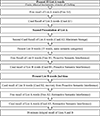Effects of Bilingualism on Verbal and Nonverbal Memory Measures in Mild Cognitive Impairment
- PMID: 30334507
- PMCID: PMC6349543
- DOI: 10.1017/S135561771800070X
Effects of Bilingualism on Verbal and Nonverbal Memory Measures in Mild Cognitive Impairment
Abstract
Objectives: Maintaining two active languages may increase cognitive and brain reserve among bilingual individuals. We explored whether such a neuroprotective effect was manifested in the performance of memory tests for participants with amnestic mild cognitive impairment (aMCI).
Methods: We compared 42 bilinguals to 25 monolinguals on verbal and nonverbal memory tests. We used: (a) the Loewenstein-Acevedo Scales for Semantic Interference and Learning (LASSI-L), a sensitive test that taps into proactive, retroactive, and recovery from proactive semantic interference (verbal memory), and (b) the Benson Figure delayed recall (nonverbal memory). A subsample had volumetric MRI scans.
Results: The bilingual group significantly outperformed the monolingual group on two LASSI-L cued recall measures (Cued A2 and Cued B2). A measure of maximum learning (Cued A2) showed a correlation with the volume of the left hippocampus in the bilingual group only. Cued B2 recall (sensitive to recovery from proactive semantic interference) was correlated with the volume of the hippocampus and the entorhinal cortex of both cerebral hemispheres in the bilingual group, as well as with the left and right hippocampus in the monolingual group. The memory advantage in bilinguals on these measures was associated with higher inhibitory control as measured by the Stroop Color-Word test.
Conclusions: Our results demonstrated a superior performance of aMCI bilinguals over aMCI monolinguals on selected verbal memory tasks. This advantage was not observed in nonverbal memory. Superior memory performance of bilinguals over monolinguals suggests that bilinguals develop a different and perhaps more efficient semantic association system that influences verbal recall. (JINS, 2019, 25, 15-28).
Keywords: Alzheimer’s; Bilingualism; Hispanics/Latinos; MCI; Memory; Proactive interference; Spanish.
Figures
Similar articles
-
An evaluation of deficits in semantic cueing and proactive and retroactive interference as early features of Alzheimer's disease.Am J Geriatr Psychiatry. 2014 Sep;22(9):889-97. doi: 10.1016/j.jagp.2013.01.066. Epub 2013 Jun 12. Am J Geriatr Psychiatry. 2014. PMID: 23768680 Free PMC article.
-
Medial Temporal Lobe Atrophy is Related to Learning Strategy Changes in Amnestic Mild Cognitive Impairment.J Int Neuropsychol Soc. 2019 Aug;25(7):706-717. doi: 10.1017/S1355617719000353. J Int Neuropsychol Soc. 2019. PMID: 31023395
-
Vulnerability to semantic and phonological interference in normal aging and amnestic mild cognitive impairment (aMCI).Neuropsychology. 2024 Jul;38(5):416-429. doi: 10.1037/neu0000945. Epub 2024 Feb 1. Neuropsychology. 2024. PMID: 38300582
-
Is bilingualism associated with enhanced executive functioning in adults? A meta-analytic review.Psychol Bull. 2018 Apr;144(4):394-425. doi: 10.1037/bul0000142. Epub 2018 Mar 1. Psychol Bull. 2018. PMID: 29494195 Review.
-
Neuropsychological, cognitive, and theoretical considerations for evaluation of bilingual individuals.Neuropsychol Rev. 2008 Sep;18(3):255-68. doi: 10.1007/s11065-008-9069-7. Epub 2008 Oct 8. Neuropsychol Rev. 2008. PMID: 18841477 Free PMC article. Review.
Cited by
-
Iranian Brain Imaging Database: A Neuropsychiatric Database of Healthy Brain.Basic Clin Neurosci. 2021 Jan-Feb;12(1):115-132. doi: 10.32598/bcn.12.1.1774.2. Epub 2021 Jan 1. Basic Clin Neurosci. 2021. PMID: 33995934 Free PMC article.
-
Integration of visual context in early and late bilingual language processing: evidence from eye-tracking.Front Psychol. 2023 Apr 26;14:1113688. doi: 10.3389/fpsyg.2023.1113688. eCollection 2023. Front Psychol. 2023. PMID: 37179896 Free PMC article.
-
Neuropsychological assessment of mild cognitive impairment in Latinx adults: A scoping review.Neuropsychology. 2020 Jul;34(5):493-510. doi: 10.1037/neu0000628. Epub 2020 Apr 13. Neuropsychology. 2020. PMID: 32281811 Free PMC article.
-
The association of multilingualism with diverse language families and cognition among adults with and without education in India.Neuropsychology. 2025 Mar;39(3):223-234. doi: 10.1037/neu0000988. Neuropsychology. 2025. PMID: 40063370
-
Effects of Second Language Learning on the Plastic Aging Brain: Functional Connectivity, Cognitive Decline, and Reorganization.Front Neurosci. 2019 May 15;13:423. doi: 10.3389/fnins.2019.00423. eCollection 2019. Front Neurosci. 2019. PMID: 31156360 Free PMC article.
References
-
- Abutalebi J, & Green D (2007). Bilingual language production: The neurocognition of language representation and control. Journal of Neurolinguistics, 20(3), 242–275. doi:10.1016/j.jneuroling.2006.10.003 - DOI
-
- Ardila A (2007). Bilingualism in the contemporary world In Ardila A & Ramos E (Eds.), Speech and language disorders in bilinguals (pp.1–20). New York: Nova Science.
Publication types
MeSH terms
Grants and funding
LinkOut - more resources
Full Text Sources
Medical


